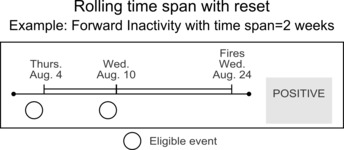Rolling time span in Forward Inactivity components
You can set either a calendar or rolling time span in Forward Inactivity components.
For both calendar and rolling time spans, the incoming event timestamp is used as the starting point of the time span.
Rolling time span
The rolling time span works differently in Forward Inactivity components from the way it works in Pattern components. The length of the span remains constant, but the start date does not move forward in time as it does with a Pattern.
In the example diagram, a Forward Inactivity has a rolling time span of two weeks, and the component is activated by a transaction with a timestamp of Thursday, August 4. No canceling event is specified.
The time span expires and the component fires 14 days later, on Thursday, August 18.
The component in the following diagram ignores any additional incoming events because reset is not enabled.

Rolling time span with reset
If reset is enabled, the component continues to listen for incoming events even after it is activated.
In the example diagram, a Forward Inactivity has a rolling time span of two weeks, and the component is activated by an event with a timestamp of Thursday, August 4. No canceling event is specified.
With reset enabled, the component would reset its time span if a second incoming event arrives with a timestamp that falls within the time span. Suppose this timestamp is Wednesday, August 10 at 9:47AM. The time span resets, and the first week of this reset time span ends at 9:47AM on Wednesday, August 17. The time span expires and the component fires on at 9:47AM on August 24.

